译林版四年级英语下册第七单元4B Unit7 教案
译林版小学英语4B Unit7What’s

四年级英语下册第七单元个性化修订Unit7 W hat‟s the matter? 第一课时教案设计: 刘敏审核人: 余美菊教学目标:1. 能听懂,会读,会说单词:happy , hungry, ill, sad,thirsty, tired, dear.2.通过学习,初步掌握表示感受或感觉的形容词,并能用What‟s the matter ? I‟m…进行问答。
并且能听懂、会说、会读日常交际用语Come and have... Good night.3. 结合生活中的情景,让学生在角色扮演中学会关心帮助他人。
教学重难点:1. 词汇:ill, thirsty和tired的发音。
2.通过学习,初步掌握表示感受或感觉的形容词,并能用What‟s the matter ? I‟m…进行问答。
并且能听懂、会说、会读日常交际用语Come and have... Good night.3. 让学生能够将所学句型运用到实际生活中,并学会关心帮助他人。
教学准备:挂图,卡片,PPT教学过程:Step 1Warming up1. GreetingsT: Good morning, class. Nice to see you.Ss: Good morning, Miss Liu. Nice to see you too.T: What day is it today?Ss: It‟s……T: Are you hot?Ss: Yes, I am. / No, I‟ m not.2. Enjoy a songSong: If you are happy.3. Free talkT: Today is very hot, right? Are you hot?Ss: Yes.T: Are you happy today?Ss: Yes, I am. / No, I‟ m not.Step 2 Presentation1. Leading in.T: I‟m happy that all of you are fine. Now let‟s see the boy in the个性化修订picture.(呈现Liu Tao图片) Is he happy?Ss: No, he isn‟t.T: Why isn‟t he happy? What‟s the matter? Let‟s ask Liu Tao:What‟s the matter? (教学本句并板书)Ss: What‟s the matter?(学生朗读本句后,给予学生4个选项A. I‟m hungry. B. I‟mthirsty. C. I‟m ill. D. I‟m tired.并教学新词汇)2. Watch and choose.T: Let‟s watch the cartoon and find out what‟s the matter with LiuTao.Watch the cartoon.Choose the answer.3. New words: thirsty, tired, ill(并复习hungry)4. Read and find.T: We know Liu Tao is thirsty and tired. How does Liu Tao say?Please read the story by yourself and underline the sentences.T: Mum and Dad are worrying about Liu Tao. What do they say?Please read it.6. Read after the tape.7. Read in role. Work in pairs.8. Think and talk.E.g.A: What‟s the matter, Liu Tao?B: I‟m thirsty. /tired...A: Here‟s some... for you. /Come and have some...B: Thank you.A: You are welcome.Step 3 Summary1. Say the sentences.询问他人怎么了?What‟s the matter?告诉别人自己不饿。
译林版(三起)四年级下册英语教案:Unit 7 What's the matter Period 1

译林版(三起)四年级下册英语教案:Unit 7 What’s thematter Period 1前言本文是针对译林版(三起)四年级下册英语教材Unit 7 What’s the matter中的第一课时进行教案设计。
主要内容为教材的目标、重点、难点、教学准备、教学过程和板书设计。
希望能够对教师备课、授课有所帮助。
教材目标1.学习并掌握几个常用的身体部位单词:head, eye, nose, mouth, ear, leg, arm, hand, foot;2.能够听、说、认读以上单词,并运用它们进行简单的英语句子表达;3.培养学生用英语表达自己身体不舒服的能力。
重点1.身体部位单词的学习和掌握;2.能够听懂简单的英语句子并给出正确的答案;3.能够用英语简单表达自己身体不舒服的状况。
难点1.如何通过英语正确描述自己的身体部位不舒服的状况;2.如何听懂以目前所学的身体部位单词组成的简单英语句子。
教学准备1.课件、录音设备、幻灯片等教学辅助工具;2.准备不同颜色的图片来说明不同的身体部位;3.通过音频和图片展示简单的英语句子;4.通过板书与学生交流和互动。
教学过程Step1: Warming up教师在黑板或幻灯片上展示不同的身体部位图片,如头部、手臂、腿、眼睛、鼻子、口、耳朵、手等,并询问学生所认识的单词,并通过这些单词引入下一步的教学。
Step 2: Presentation教师通过音频或图片展示不同的身体部位,并教授单词 head, eye, nose, mouth, ear, leg, arm, hand, foot,并加强学生对于每一个单词的发音和拼写的理解。
Step 3: Practice1.教师播放音频,让学生聆听简单的英语句子,并找出简单句子中包含的身体部位单词并标注到上一步中展示的相关图片上;2.教师将学生分组,让学生之间进行互动,假设一个小组的学生不舒服,其他同学则需用英语问及“what’s the matter?”。
牛津译林版四年级英语下册4B U7 What’s the matter 单元教案

Listen and guess, teach“sad”
6.Recall Story time
Make a new dialogue according to Story time.
Have…Here’s…
7.Group work
T: If your friends are tired, ill, hungry or thirsty, how to help them?
Yes. He’s very funny. Look, he brings some words to us.
呈现full,bored,fine, sleepy, afraid,nervous,scared。
T:Can you find the hidden word?
T:Yes, it’s feelings.
(3) Let’s tick.
T:Ticking time.I can talk about feelings.Please tick in pairs.
2.Sound time
(1)T: Do you like making friends?The clown brings a new friend to us. It’s letter“o”.
T:Look at these words.Can you read?
教学难点
会初步运用句型What’s the matter? Come and have…CanIhave…? I want to…Are you…?进行对话。
课前准备
挂图,卡片,录音机
教学过程
Step 1 Preparation
译林版四年级英语下册unit7教案

译林版四年级英语下册unit7教案一、教学内容本节课我们将学习译林版四年级英语下册Unit 7《Whose clothes are these?》的内容。
具体包括:Story time部分的课文,学习衣物类名词及对应关系,理解一般疑问句“Whose are these?”的用法及回答。
二、教学目标1. 能够听懂、准确说出Story time中的句子,并能运用到实际场景中。
2. 能够运用所学衣物类名词及关系词,进行一般疑问句“Whose are these?”的提问和回答。
3. 培养学生的合作意识和口语表达能力。
三、教学难点与重点1. 教学难点:一般疑问句“Whose are these?”的构造及回答。
2. 教学重点:衣物类名词及关系词的掌握,以及在实际场景中的应用。
四、教具与学具准备1. 教具:PPT、卡片、磁铁、衣物模型。
2. 学具:学生用书、练习册、彩笔。
五、教学过程1. 导入:通过展示一幅衣物混在一起的图片,引导学生进行观察,激发学生的学习兴趣。
2. 新课内容:学习Story time部分,讲解衣物类名词及关系词,引导学生进行一般疑问句“Whose are these?”的提问和回答。
3. 例题讲解:结合PPT,讲解例题,让学生了解如何在实际场景中运用所学知识。
4. 随堂练习:组织学生进行小组讨论,互相提问,巩固所学知识。
5. 小组活动:每组选择一幅衣物混在一起的图片,用所学知识进行提问和回答,评选出最佳小组。
六、板书设计1. 板书Unit 7 Whose clothes are these?2. 内容:衣物类名词、关系词、一般疑问句“Whose are these?”及回答。
七、作业设计1. 作业题目:根据所学内容,编写一段对话,描述衣物混在一起的场景,并用一般疑问句“Whose are these?”进行提问和回答。
2. 答案示例:A: Look at these clothes. Whose clothes are these?B: These are my clothes. The blue shirt is mine, and the red pants are yours.八、课后反思及拓展延伸1. 课后反思:本节课学生的参与度较高,但在一般疑问句的构造和回答方面,部分学生还存在一定困难,需要在课后进行巩固。
译林版四年级英语下册unit7教案

译林版四年级英语下册unit7教案一、教学内容本节课选自译林版四年级英语下册Unit 7《Whose clothes are these?》,教学内容包括:Story time、Fun time、Cartoon time和Sound time四个部分。
具体章节内容为Story time部分,讲述了衣物归属的问题,通过此话题引导学生学习一般疑问句“Whoseare these?”及其回答。
二、教学目标1. 能够听懂、会说、会认读一般疑问句“Whoseare these?”及其回答。
2. 能够运用目标句型询问和描述衣物的归属。
3. 能够理解并表演故事内容,提高学生的英语口语表达能力。
三、教学难点与重点重点:一般疑问句“Whoseare these?”及其回答。
难点:正确使用“Whose”询问归属,并在实际情景中进行灵活运用。
四、教具与学具准备1. 教师准备:PPT、卡片、衣物模型等。
2. 学生准备:课本、练习本、彩笔等。
五、教学过程1. 导入:通过展示衣物图片,引导学生用英语描述,复习旧知,为新课学习做好铺垫。
2. 新课呈现:a. 教师播放Story time录音,学生跟读,理解故事内容。
b. 教师引导学生学习一般疑问句“Whoseare these?”及其回答,并进行角色扮演。
c. 学生自主阅读Fun time部分,完成练习,巩固所学知识。
3. 例题讲解:教师针对一般疑问句“Whoseare these?”进行讲解,并给出例句。
4. 随堂练习:学生两人一组,用目标句型进行对话练习。
六、板书设计1. Unit 7 Whose clothes are these?2. 主要句型:Whoseare these?They're3. 重点词汇:clothes, hat, coat, whose七、作业设计1. 作业题目:a. 根据板书,编写一段关于衣物归属的对话。
b. 收集家庭成员的衣物,用英语介绍并拍照。
译林版牛津小学英语4B Unit 7 At a snack bar教案

牛津小学英语4B Unit 7 At a snack bar教学方案4A Unit 7 教学方案(第一课时)第一部分简要提示一、年级:4年级二、单元:Unit 7三、课题:At a snack bar四、课型:新授课五、教学内容:单元Part A六、教学目标:1、能听懂、会说、会读单词hamburger, noodles, juice, coffee,2、能听懂、会说、会读句型How about you? Some…, please. Somethingto drink? Anything else?七、重难点:初步了解句型:How about you? Some…, please. Something todrink?Anything else?第二部分教学过程第一步:重难点突破T:Hello, boys and girls. Nice to meet you.同学们,你们好,今天我们学习牛津小学英语4B第七单元At a snack bar。
你们知道什么是snack bar 吗?(课件出示图片)Look, this is a snack bar.snack bar指的是小吃店,snack的意思是小吃,零食。
T:There are many food in it. What can you see?T:(PPT出示图片:cake, noodles, hamburgers, pies, tea, milk, juice, coffee)(老师依次带读并教授)So many delisious food. 这么多好吃的东西,Would you like something to eat or drink?你想要吃点或喝点什么吗?(PPT出示句型‘Something to eat/Something to drink?’,带读)I’d like some hamburgers and some coffee. 我想要一些汉堡包和咖啡。
译林版四年级下册英语教案:Unit 7 What’s the matter? 单元教案

译林版四年级下册英语教案:Unit 7 What’s the matter?教学目标1.能听、说、读、写单词和短语:matter,toothache,headache,stomachache,cold,sore throat,fever, cough;2.能听懂并简单运用日常用语,询问他人的身体状况;3.能够用What’s the matter?来问别人身体不适的原因;4.能了解并掌握洗手的重要性,养成良好的卫生习惯。
教学重难点1.询问别人身体不适的原因和反应;2.锻炼学生的口语表达能力;3.培养学生良好的个人卫生习惯。
教学过程Step 1. Warming up1.Greeting: Good morning/afternoon, class.2.Ask some general and review questions about the previous English lessons, such as:•What did we learn about colors?•What did we learn about food and drinks?•What did we learn about clothes?Step 2. Presentation1.Show students some pictures of people who may feel sick, such as someone with a headache or stomachache.2.Ask students, What’s the matter? to elicit the target language.3.Teach the students the new words and phrases: matter, toothache, headache, stomachache, cold, sore throat, fever, cough. Have the students repeat the words after the teacher.e the pictures to teach the phrases: He/She has atoothache/headache/stomachache/cold/sore throat/fever/cough.Step 3. Practice1.Role play: Divide the students into pairs. One student plays the role of someone who feels sick, and the other student plays the role of the doctor. The doctor asks What’s the matter? and the patient answers with one of the phrases they have learned.2.Class survey: Have the students survey each other about how they are feeling today. The students ask each other, How are you feeling today? and answer with one of the phrases they have learned.3.Song activity: Play the song “Head, Shoulders, Knees and Toes” and have the students sing and touch their body parts.4.Demonstrate and practice washing hands: Use a hand washing poster to demonstrate how to wash hands properly, and have the studentspractice washing their hands.Step 4. Production1.Show pictures of some situations and have the students answer the question, What’s the matter? and make suggestions about what the person should do. For example, if the picture shows someone coughing, the students can say, He/She has a cough. He/She should drink some warm water.2.Worksheets: Have the students complete worksheets about the target language, match the symptoms with the pictures, and fill in the blanks with the correct words.Step 5. Wrap up1.Recap the target language, phrases, and structures that they have learned in this lesson.2.Assign homework activities, such as reviewing the new vocabulary words and phrases and practicing them with family members.教学反思在本次课程中,我采用了多种教学方法,包括图片演示、角色扮演、问卷调查、歌曲活动和手工活动等,这些活动丰富了课堂氛围,并激发了学生参与的积极性。
四年级下册英语教案-Unit7 What’s the matter Story time译林版(三起

四年级下册英语教案-Unit7 What’s the matter Story time译林版(三起)一、教学目标1.能听懂、会读、会说本课的单词和短语;2.能够听懂并理解与本课有关的简单对话;3.能够通过模仿,正确表达自己的身体不适和询问他人的身体状况;4.通过教授本节课的故事,激发学生学习英语的兴趣,加深学生对课文的理解和记忆;5.培养学生积极、主动的学习态度和团队精神。
二、教学重点1.能够听懂并正确理解本课的对话;2.能够正确表达自己的身体不适并询问他人的身体状况。
三、教学难点1.能够通过故事的形式,加深学生的理解和记忆;2.能够准确使用英语词汇表达身体不适和询问他人的身体状况。
四、教学过程(一)热身1.让学生用英语介绍自己的身体部位;2.通过游戏方式,让学生尝试说出身体状况。
(二)新课呈现1.听录音,学习本课的单词和短语;2.通过听故事的方式,学习和理解本课的故事。
(三)教师示范1.教师模仿生病的动作和表情,让学生猜测教师的身体状况;2.教师通过模仿自己生病的表现,让学生练习表达。
(四)小组活动1.学生组成小组,互相模仿生病的表现,并进行交流和表达;2.在小组内,同学们互相询问身体状况,并互相给出建议和帮助。
(五)本课故事1.教师讲解本课故事,让学生仔细听,理解故事情节;2.学生跟读故事,加深理解和记忆。
(六)语言拓展1.教师引导学生学习并掌握表达身体不适和询问身体状况的句子;2.学生模仿教师,进行表达和练习。
五、教学总结通过本节课的学习,学生掌握了与身体状况相关的英语词汇和句子。
通过教授本课的故事,激发学生学习英语的兴趣,加深学生对课文的理解和记忆。
同时,在小组活动中,学生加强了团队意识和合作精神。
译林4Bunit7教案
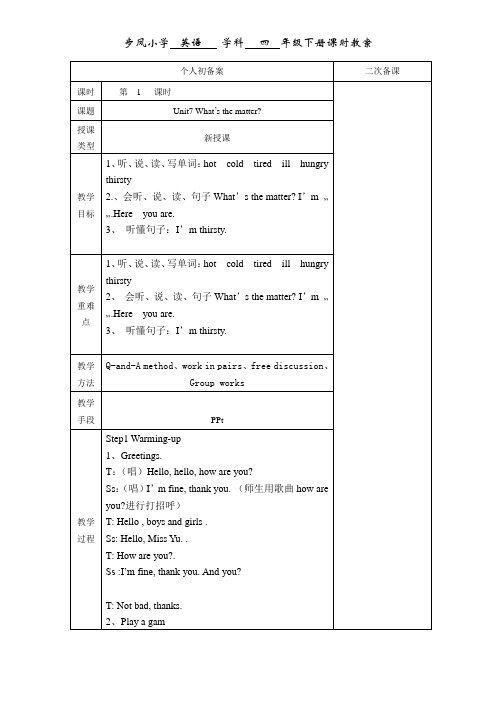
个人初备案二次备课课时第 1 课时课题Unit7 What’s the matter?授课类型新授课教学目标1、听、说、读、写单词:hot cold tired ill hungry thirsty2.、会听、说、读、句子What’s the matter? I’m …….Here you are.3、听懂句子:I’m thirsty.教学重难点1、听、说、读、写单词:hot cold tired ill hungry thirsty2、会听、说、读、句子What’s the matter? I’m …….Here you are.3、听懂句子:I’m thirsty.教学方法Q-and-A method、work in pairs、free discussion、Group works教学手段PPt教学过程Step1 Warming-up1、Greetings.T:(唱)Hello, hello, how are you?Ss:(唱)I’m fine, thank you. (师生用歌曲how are you?进行打招呼)T: Hello , boys and girls .Ss: Hello, Miss Yu. .T: How are you?.Ss :I’m fine, thank you. And you?T: Not bad, thanks.2、Play a gamHere's a ...for you .的句型,复习这一句型是为下面的学习作好铺垫作用。
)Step 2 Presentation1、学习thirsty (多媒体出示图片)T:I’m not hungry.I’m thirsty.Can I have some water?2.引出教学What’s the matter?和tired.Today, we will have a new friend. Look, she’s coming.(媒体出示卖火柴的小女孩)Who’s she?T: She’s little match girl.。
译林版四年级英语下册unit7教案
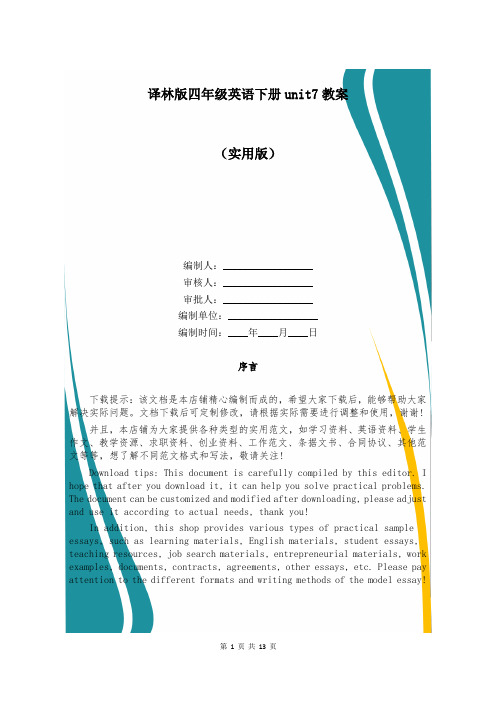
译林版四年级英语下册unit7教案(实用版)编制人:__________________审核人:__________________审批人:__________________编制单位:__________________编制时间:____年____月____日序言下载提示:该文档是本店铺精心编制而成的,希望大家下载后,能够帮助大家解决实际问题。
文档下载后可定制修改,请根据实际需要进行调整和使用,谢谢!并且,本店铺为大家提供各种类型的实用范文,如学习资料、英语资料、学生作文、教学资源、求职资料、创业资料、工作范文、条据文书、合同协议、其他范文等等,想了解不同范文格式和写法,敬请关注!Download tips: This document is carefully compiled by this editor. I hope that after you download it, it can help you solve practical problems. The document can be customized and modified after downloading, please adjust and use it according to actual needs, thank you!In addition, this shop provides various types of practical sample essays, such as learning materials, English materials, student essays, teaching resources, job search materials, entrepreneurial materials, work examples, documents, contracts, agreements, other essays, etc. Please pay attention to the different formats and writing methods of the model essay!译林版四年级英语下册unit7教案能听懂、会说:What's in the classroom? Aboard, two lights, many desks and chairs.并能在实际情景中运用。
译林版四年级英语下册第七单元4B Unit7 教案
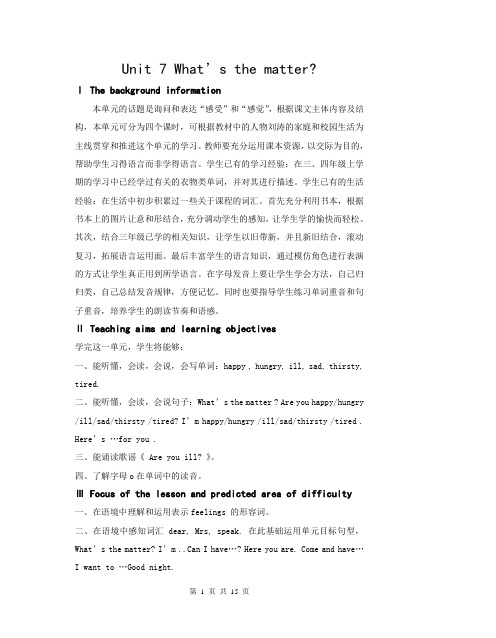
Unit 7 What’s the matter?Ⅰ The background information本单元的话题是询问和表达“感受”和“感觉”,根据课文主体内容及结构,本单元可分为四个课时,可根据教材中的人物刘涛的家庭和校园生活为主线贯穿和推进这个单元的学习。
教师要充分运用课本资源,以交际为目的,帮助学生习得语言而非学得语言。
学生已有的学习经验:在三、四年级上学期的学习中已经学过有关的衣物类单词,并对其进行描述。
学生已有的生活经验:在生活中初步积累过一些关于课程的词汇。
首先充分利用书本,根据书本上的图片让意和形结合,充分调动学生的感知,让学生学的愉快而轻松。
其次,结合三年级已学的相关知识,让学生以旧带新,并且新旧结合,滚动复习,拓展语言运用面。
最后丰富学生的语言知识,通过模仿角色进行表演的方式让学生真正用到所学语言。
在字母发音上要让学生学会方法,自己归归类,自己总结发音规律,方便记忆。
同时也要指导学生练习单词重音和句子重音,培养学生的朗读节奏和语感。
Ⅱ Teaching aims and learning objectives学完这一单元,学生将能够:一、能听懂,会读,会说,会写单词:happy , hungry, ill, sad, thirsty, tired.二、能听懂,会读,会说句子:What’s the matter ? Are you happy/hungry /ill/sad/thirsty /tired? I’m happy/hungry /ill/sad/thirsty /tired . Here’s …for you .三、能诵读歌谣《 Are you ill? 》。
四、了解字母o在单词中的读音。
Ⅲ Focus of the lesson and predicted area of difficulty一、在语境中理解和运用表示feelings 的形容词。
二、在语境中感知词汇dear, Mrs, speak. 在此基础运用单元目标句型,What’s the matter? I’m ..Can I have…? Here you are. Come and have…I want to …Good night.三、最终让学生产生主动关心帮助他人的情感体验。
【教育资料】四年级下册英语教案 Unit7 What’s the matter (第2课时)译林版(三起)学习精品

4B Unit7第二课时教案一、教学内容Unit7 What’s the matter? (Fun time , Cartoon time &Rhyme time)二、教学目标1. 通过情境表演巩固所学感觉类单词,能听懂、会说、会读happy , hungry,ill, sad, thirsty, tired.2. 通过小组合作表演游戏,能够听懂、会说、会读句型What’s the matter?以及应答句I’m…;Are you happy/hungry /ill/sad/thirst y /tired? I’m happy/hungry /ill/sad/thirsty /tired . Here’s …… for you .给予同伴正确具体的帮助;3.能够理解Cartoon time故事内容并能生动表演。
4.会熟练朗读Rhyme time.5.在互动情感体验中,感受人与人之间的关爱。
三、教学重点1. 通过情境表演巩固所学感觉类单词,能听懂、会说、会读happy, hungry, ill, sad, thirsty, tired.2. 在表演游戏中,能够听懂、会说、会读句型What’s the matter?以及应答句I’m…Are you happy/hungry /ill/sad/thirsty /tired? I’m happy/hungry/ill/sad/thirsty /tired .Here’s ……for you .3. 通过小组合作及表演游戏,学生能够熟练运用句型What’s the matter?以及应答句I’m…;并能熟练运用单词表示感觉,同时给予同伴正确具体的帮助;4、会熟练朗读Rhyme time教学难点1、根据图片提示,能大声流利地朗读并与同桌对话。
通过小组合作及表演游戏,学生能够熟练运用句型What’s the matter?以及应答句I’m…;并能熟练运用单词表示感觉,同时给予同伴正确具体的帮助;2、初步了解电话用语及表达。
新译林牛津小学英语四年级(下册)Unit7教学案
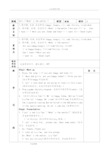
说说本课学习的知识点,看谁得的笑脸多。
Step4 Homework
1.Read…
2.Copy…
3.Act…
Unit 7 What’s the matter ?
课型
新授
课时
2
教
学
目
标
1.通过情境表演巩固所学感觉类单词,能听懂、会说、会读thirsty, ill,tired,happy;
Can you help Liu Tao? Please use “Have…”(a hamburger / a hot dog学生发挥)
3.Chant:Areyou thirsty?Are you thirsty?
No, I’m not. No, I’m not.
What’s the matter, Taotao? What’s the matter, Taotao?
I am ______. I am ______.
6.(Liu Tao回家后)T: His parents are concerd with Liu Tao, they encourage him.
Watch and choose看动画选择What’s the matter with Liu Tao? He’s…
\ Ss: Thanks./Thank you.
2.T: Look at Liu Tao, ask him please.
Ss: What’s the matter, Liu Tao?
T: Are you thirsty?(教师引导学生问,并且板书句子)
T:Oh, Liu Tao says: I’m not thirsty. I’m hungry. (单词hungry出示并板书)
译林版小学英语四年级下册unit7教案(英文)
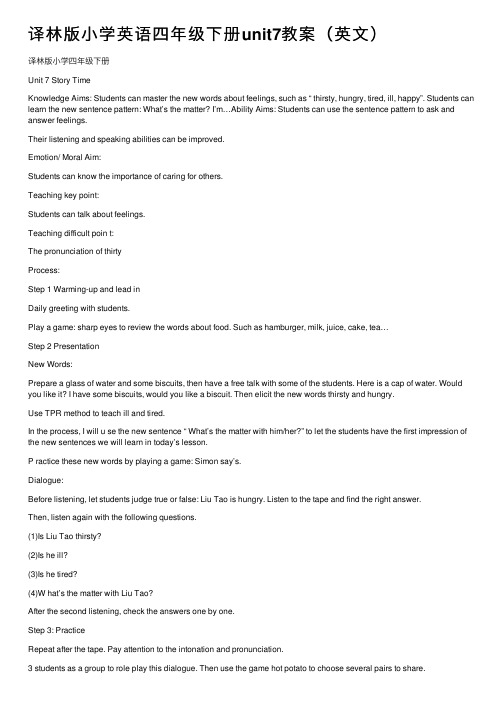
译林版⼩学英语四年级下册unit7教案(英⽂)译林版⼩学四年级下册Unit 7 Story TimeKnowledge Aims: Students can master the new words about feelings, such as “ thirsty, hungry, tired, ill, happy”. Students can learn the new sentence pattern: What’s the matter? I’m…Ability Aims: Students can use the sentence pattern to ask and answer feelings.Their listening and speaking abilities can be improved.Emotion/ Moral Aim:Students can know the importance of caring for others.Teaching key point:Students can talk about feelings.Teaching difficult poin t:The pronunciation of thirtyProcess:Step 1 Warming-up and lead inDaily greeting with students.Play a game: sharp eyes to review the words about food. Such as hamburger, milk, juice, cake, tea…Step 2 PresentationNew Words:Prepare a glass of water and some biscuits, then have a free talk with some of the students. Here is a cap of water. Would you like it? I have some biscuits, would you like a biscuit. Then elicit the new words thirsty and hungry.Use TPR method to teach ill and tired.In the process, I will u se the new sentence “ What’s the matter with him/her?” to let the students have the first impression of the new sentences we will learn in today’s lesson.P ractice these new words by playing a game: Simon say’s.Dialogue:Before listening, let students judge true or false: Liu Tao is hungry. Listen to the tape and find the right answer.Then, listen again with the following questions.(1)Is Liu Tao thirsty?(2)Is he ill?(3)Is he tired?(4)W hat’s the matter with Liu Tao?After the second listening, check the answers one by one.Step 3: PracticeRepeat after the tape. Pay attention to the intonation and pronunciation.3 students as a group to role play this dialogue. Then use the game hot potato to choose several pairs to share.Step 4: ProductionGroup work: say and act. One student pretends to be unhappy, thirsty, ill or tired, the other students should ask “ What’s the matter? Are you…?”They will be asked to show their results in front of the class.Step 5 Summary and HomeworkStudents will summarize what they learned today。
译林版四年级英语下册unit7优质教案
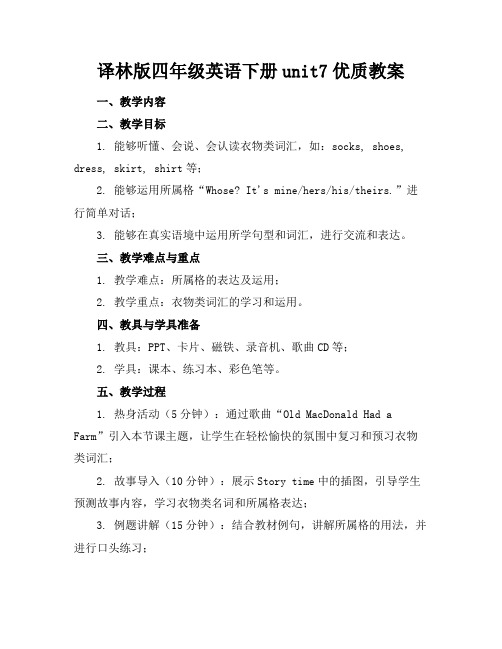
译林版四年级英语下册unit7优质教案一、教学内容二、教学目标1. 能够听懂、会说、会认读衣物类词汇,如:socks, shoes, dress, skirt, shirt等;2. 能够运用所属格“Whose? It's mine/hers/his/theirs.”进行简单对话;3. 能够在真实语境中运用所学句型和词汇,进行交流和表达。
三、教学难点与重点1. 教学难点:所属格的表达及运用;2. 教学重点:衣物类词汇的学习和运用。
四、教具与学具准备1. 教具:PPT、卡片、磁铁、录音机、歌曲CD等;2. 学具:课本、练习本、彩色笔等。
五、教学过程1. 热身活动(5分钟):通过歌曲“Old MacDonald Had a Farm”引入本节课主题,让学生在轻松愉快的氛围中复习和预习衣物类词汇;2. 故事导入(10分钟):展示Story time中的插图,引导学生预测故事内容,学习衣物类名词和所属格表达;3. 例题讲解(15分钟):结合教材例句,讲解所属格的用法,并进行口头练习;4. 随堂练习(15分钟):进行Fun time活动,分组进行角色扮演,运用所学句型和词汇进行对话;5. 歌曲学唱(10分钟):学唱Song time中的歌曲,巩固衣物类词汇;6. 写作与表达(15分钟):完成Write and say部分,书写和口头描述衣物归属;六、板书设计1. Unit 7 Whose clothes are these?2. 主要内容:衣物类词汇:socks, shoes, dress, skirt, shirt等;所属格句型:Whose? It's mine/hers/his/theirs.七、作业设计1. 作业题目:a. 根据所给图片,用所属格句型描述衣物归属;b. 编写一段对话,运用所学衣物类词汇和所属格表达。
2. 答案:a. 图片描述例:Whose socks are these? They're mine.b. 对话编写例:A: Whose dress is this?B: It's hers.A: And whose shoes are those?B: They're mine.八、课后反思及拓展延伸1. 课后反思:关注学生在课堂上的表现,针对学生的掌握情况,调整教学方法和节奏;2. 拓展延伸:鼓励学生在课后观察生活中衣物归属的场景,用所学知识进行描述和交流,提高英语实际运用能力。
四年级下册英语教案-Unit 7 What’s the matter Period 4 -译林版三起
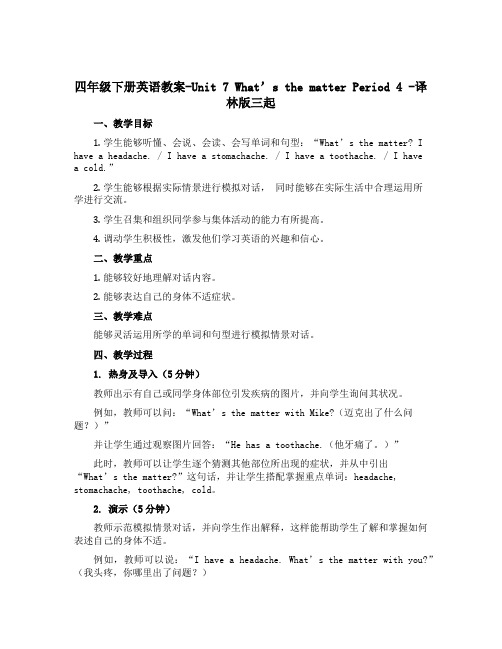
四年级下册英语教案-Unit 7 What’s the matter Period 4 -译林版三起一、教学目标1.学生能够听懂、会说、会读、会写单词和句型:“What’s the matter? I have a headache. / I have a stomachache. / I have a toothache. / I havea cold.”2.学生能够根据实际情景进行模拟对话,同时能够在实际生活中合理运用所学进行交流。
3.学生召集和组织同学参与集体活动的能力有所提高。
4.调动学生积极性,激发他们学习英语的兴趣和信心。
二、教学重点1.能够较好地理解对话内容。
2.能够表达自己的身体不适症状。
三、教学难点能够灵活运用所学的单词和句型进行模拟情景对话。
四、教学过程1. 热身及导入(5分钟)教师出示有自己或同学身体部位引发疾病的图片,并向学生询问其状况。
例如,教师可以问:“What’s the matter with Mike?(迈克出了什么问题?)”并让学生通过观察图片回答:“He has a toothache.(他牙痛了。
)”此时,教师可以让学生逐个猜测其他部位所出现的症状,并从中引出“What’s the matter?”这句话,并让学生搭配掌握重点单词:headache, stomachache, toothache, cold。
2. 演示(5分钟)教师示范模拟情景对话,并向学生作出解释,这样能帮助学生了解和掌握如何表述自己的身体不适。
例如,教师可以说:“I have a headache. What’s the matter with you?”(我头疼,你哪里出了问题?)3. 训练(20分钟)教师出示相关练习题目(请看教材第10页,Part 1和Part 2的练习题),让学生根据题目做出相应的回答。
4. 整合(5分钟)教师可邀请学生参与实际情景模拟对话,这样可以根据学生的实际表现情况和需要,有序的展开总结和补充教学内容。
译林小学英语四年级下册Unit7What’sthematter教案
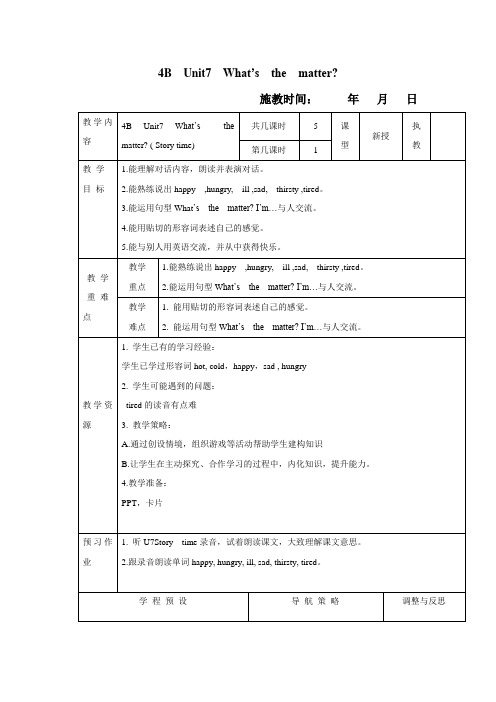
导入课题,板书课题。
2. Watch the cartoon. 听课文录音,回答问题 (1)Is Liu Tao hungry?
(2) Is he thirty? (3) Is he ill? (4) Is he tired? (5) What’s the matter with Liu Tao? (6)What Tao ? would you like to say to Liu 教师播放课文录音,校正答案。
教师评价
明确作业要求。
有感情地表演 2.Make a dialogue.
E. Homework. (1 分钟) *听磁带,有感情地模仿熟读课文并尝试背 诵。 **背诵单词
教后反思:
4b Unit7 what’s the matter?
施教时间: 教学内 容 4b Unit7 what’s the matter? Fun time& Sound time& rhyme time 教 学 目 标 1.能熟练说出 happy ,hungry, ill ,sad, thirsty ,tired。 2.能运用句型 What’s the matter? I’m…与人交流。 3.通过绕口令,学习字母 o 的发音,并尝试举一反三 4.能演唱歌曲 are you ill?并尝试创新改编。 共几课时 第几课时 5 2 课
预 习 作 1. 听 U7Story time 录音,试着朗读课文,大致理解课文意思。 业 2.跟录音朗读单词 happy, hungry, ill, sad, thirsty, tired。
学 程 预 设
导 航 策 略
调整与反思
A.Learning aims(2 分钟) 1. 能 熟 练说 出 happy thirsty ,tired。 2.能运用句型 What’s the matter? I’m… 与人交流。 3.能用贴切的形容词表述自己的感觉。 4.能与别人用英语交流,并从中获得快乐。 B. Pre-reading(6 分钟) 1.Play a game. guess:what’s in my bag? 师出示装有各种物体的包,先让 学生猜有些什么食物,帮助学生 复习饮料,食物,水果类单词。 PPT 出示本课学习目标 ,hungry, ill ,sad,
牛津译林版四年级英语下册(4B)Revision of Unit 7 课件
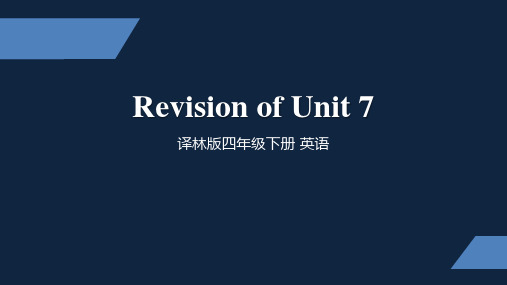
Let's read
Let's read
Let's read
Let's read
Let's read
Let's read
Let's read
Let's answer
What's the matter with Tommy?
He's hungry.
Let's think
What does he want?
Liu Tao
Mind map
excited
happy
good feelings
good
great
feelings
hungry
bad feelings
sad cold
HHoowwdotyoou aasks? k?
怎么你怎问么感问感觉觉 ? thirsty tired
Let's say
How are you?
)
cmhpjnolfooehopoksrpxotpeoeteno
fox not
同学们,还记得这三个飞走的 球吗?字母o的发音不一样哦!
mop
Rhyme time O /əu / O /? /
Rhyme time O /כ/
hot
Read and make a sentence. 读一读,再用其中的词造句。
1. What‘s the matter? Are you ...?
2. What's wrong?
Let's ask
你可以怎么关心Bobby?
1. What‘s the matter? Are you ill?
新译林 4B Unit7 What's the matter 6课时教案
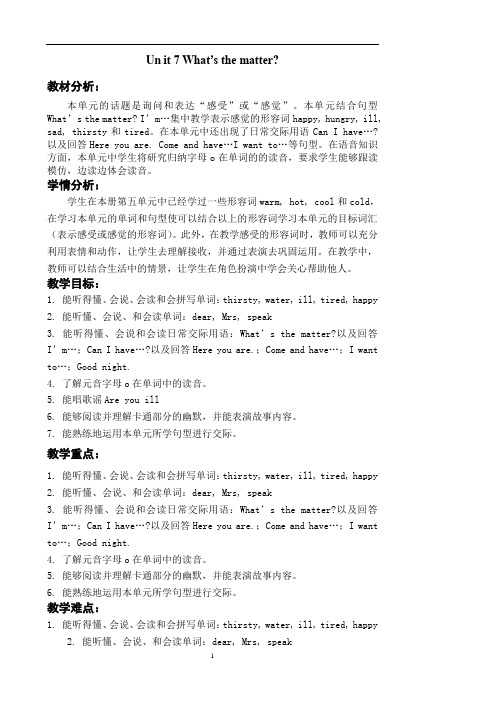
Un it 7 What’s the matter?教材分析:本单元的话题是询问和表达“感受”或“感觉”。
本单元结合句型What’s the matter? I’m…集中教学表示感觉的形容词happy, hungry, ill, sad, thirsty和tired。
在本单元中还出现了日常交际用语Can I have…?以及回答Here you are. Come and have…I want to…等句型。
在语音知识方面,本单元中学生将研究归纳字母o在单词的的读音,要求学生能够跟读模仿,边读边体会读音。
学情分析:学生在本册第五单元中已经学过一些形容词warm, hot, cool和cold,在学习本单元的单词和句型使可以结合以上的形容词学习本单元的目标词汇(表示感受或感觉的形容词)。
此外,在教学感受的形容词时,教师可以充分利用表情和动作,让学生去理解接收,并通过表演去巩固运用。
在教学中,教师可以结合生活中的情景,让学生在角色扮演中学会关心帮助他人。
教学目标:1. 能听得懂、会说、会读和会拼写单词:thirsty, water, ill, tired, happy2. 能听懂、会说、和会读单词:dear, Mrs, speak3. 能听得懂、会说和会读日常交际用语:What’s the matter?以及回答I’m…;Can I have…?以及回答Here you are.;Come and have…;I want to…;Good night.4. 了解元音字母o在单词中的读音。
5. 能唱歌谣Are you ill6. 能够阅读并理解卡通部分的幽默,并能表演故事内容。
7. 能熟练地运用本单元所学句型进行交际。
教学重点:1. 能听得懂、会说、会读和会拼写单词:thirsty, water, ill, tired, happy2. 能听懂、会说、和会读单词:dear, Mrs, speak3. 能听得懂、会说和会读日常交际用语:What’s the matter?以及回答I’m…;Can I have…?以及回答Here you are.;Come and have…;I want to…;Good night.4. 了解元音字母o在单词中的读音。
- 1、下载文档前请自行甄别文档内容的完整性,平台不提供额外的编辑、内容补充、找答案等附加服务。
- 2、"仅部分预览"的文档,不可在线预览部分如存在完整性等问题,可反馈申请退款(可完整预览的文档不适用该条件!)。
- 3、如文档侵犯您的权益,请联系客服反馈,我们会尽快为您处理(人工客服工作时间:9:00-18:30)。
Unit 7 What’s the matter?Ⅰ The background information本单元的话题是询问和表达“感受”和“感觉”,根据课文主体内容及结构,本单元可分为四个课时,可根据教材中的人物刘涛的家庭和校园生活为主线贯穿和推进这个单元的学习。
教师要充分运用课本资源,以交际为目的,帮助学生习得语言而非学得语言。
学生已有的学习经验:在三、四年级上学期的学习中已经学过有关的衣物类单词,并对其进行描述。
学生已有的生活经验:在生活中初步积累过一些关于课程的词汇。
首先充分利用书本,根据书本上的图片让意和形结合,充分调动学生的感知,让学生学的愉快而轻松。
其次,结合三年级已学的相关知识,让学生以旧带新,并且新旧结合,滚动复习,拓展语言运用面。
最后丰富学生的语言知识,通过模仿角色进行表演的方式让学生真正用到所学语言。
在字母发音上要让学生学会方法,自己归归类,自己总结发音规律,方便记忆。
同时也要指导学生练习单词重音和句子重音,培养学生的朗读节奏和语感。
Ⅱ Teaching aims and learning objectives学完这一单元,学生将能够:一、能听懂,会读,会说,会写单词:happy , hungry, ill, sad, thirsty, tired.二、能听懂,会读,会说句子:What’s the matter ? Are you happy/hungry /ill/sad/thirsty /tired? I’m happy/hungry /ill/sad/thirsty /tired . Here’s …for you .三、能诵读歌谣《 Are you ill? 》。
四、了解字母o在单词中的读音。
Ⅲ Focus of the lesson and predicted area of difficulty一、在语境中理解和运用表示feelings 的形容词。
二、在语境中感知词汇dear, Mrs, speak. 在此基础运用单元目标句型,What’s the matter? I’m ..Can I have…? Here you are. Come and have…I want to …Good night.三、最终让学生产生主动关心帮助他人的情感体验。
教学光盘,单词卡片,人物头饰,课件Ⅴ Periods第一课时: Story time第二课时: Fun time and Cartoon time第三课时: Sound time, Rhyme time, Checkout time&Ticking time第四课时: Checkout time and Ticking time第五课时: Do exercise book for Unit 7第七单元第一课时(课型:新授课设计:授课时间:月日)Ⅰ Teaching contentUnit7 Story timeⅡ Teaching aims and learning objectives学完这一课,学生将能够:一、能听懂,会读,会说单词:happy , hungry, ill, sad, thirsty, tired,dear.二、能听懂,会读,会说句子:What’s the matter ? Are you…? I’m ... Can Ihave …? Here you are./Come and have…/ I want to…/ Goodnight.Ⅲ Focus of the lesson and predicted area of difficulty一、能听懂,会读,会说单词:happy, hungry, ill, sad, thirsty, tired,dear.二、能听懂,会读,会说句子:What’s the matter? Are you happy/hungry/ill/sad/thirsty /tired? I’m happy/hungry /ill/sad/thirsty /tired .Can I have…?Hereyou are.I want to ..../Good night.Ⅳ Teaching aids教学光碟,单词卡片,人物头饰,多媒体(PPT)Ⅴ Teaching procedures Array Step1: Warm up1.Enjoy the song < If you are happy and know it>2.T: Boys and girls, are you happy today? I think you are. (出示单词happy并且板书)T: Let’s look what we are going to learn in thisclass. (教学目标出示,并且引导孩子们得笑脸。
)3.Play a game: Quickly respond. 在游戏中教学单词water。
(出示单词并且板书)4.(出示人物Liu Tao)T:We’re happy today. But my friend Liu Taoisn’t happy. He’s sad.(出示单词sad,并且教学)Liu Tao is good atrunning.But he failed in the 400 meters race in the sports meeting.So he’s sad now.(故事的引子)Step2: PresentationT: Let’s ask Liu Tao:“ What’s the matter?”(播放录音,并且板书教读句子。
)I’m thirsty.(出示单词thirsty,教读。
)T: Let’s help him , please say: Have some water.(出示句子,并且板书。
)Ss: Thanks./Thank you.T: Look at Liu Tao, ask him please.Ss: What’s the matter, Liu Tao?T: Are you thirsty?(教师引导学生问,并且板书句子)T:Oh, Liu Tao says: I’m not thirsty. I’m hungry. (单词hungry出示并板书)Can you help Liu Tao? Please use “Have…”(a hamburger / a hot dog学生发挥)Chant: Are you thirsty?Are you thirsty?No, I’m not. No, I’m not.What’s the matter, Taotao? What’s the matter, Taotao? I am hungry. I am hungry.5. 自编一个chant: Are you ______? Are you ______? No, ___ ___. No, ___ ___.What’s the ______, Taotao? What’s the ______, Taotao?I am ______. I am______.6.(Liu Tao 回家后)T: His parents are concerd with Liu Tao, they encourage him.Watch and choose 看动画选择What’s the matter with Liu Tao? He’s …A. happyB. hungryC. thirstyD. illE. tired7. Read and answer.(自读课文找出答案)How does Liu Tao ask his mother? (刘涛口渴了,他是如何向妈妈要求的?)S:Can I have some water?8. Read after the tape.(跟录音读,老师师范朗读,学生模仿语音语调,升降调的朗读。
)在朗读过程中随文教学I want to … Good night, dear. (T: Liu Tao wasn’t happy at first, but now he’s not sad.)9. Reading Time : Read the whole story together.Act the story(三人一小组)Step3: Consolidation1). Summary:1、邀请对方过来吃东西,可以说:2、询问对方怎么了,可以问:/回答饿了。
3、询问对方是否口渴,可以问:(不,不口渴。
)4、向对方要求拿点水喝,可以说:5、表示自己想要做某事,可以说:6、跟家人道晚安,可以说:2)Ticking Time说说本课学习的知识点,看谁得的笑脸多。
Ⅵ Homework1. Read the dialogue with expression 3 times.2.Practice the dialogue with your partners using the sentences thatwe have learned.Blackboard design:Unit7 what’s the matter?what’s the matter?I’m...Teaching reflection:第七单元第二课时(课型:新授课设计:授课时间:月日)Ⅰ Teaching contentUnit7 Fun time and Cartoon timeⅡ Teaching aims and learning objectives学完这一课,学生将能够:一、通过情境表演巩固所学感觉类单词,能听懂、会说、会读thirsty, ill,tired,happy。
二、在表演游戏中,能够听懂、会说、会读句型What’s the matter?以及应答句I’m…。
三、通过小组合作及表演游戏,学生能够熟练运用句型What’s the matter?以及应答句I’m…;并能熟练运用单词表示感觉,同时给予同伴正确具体的帮助。
四、能够理解Cartoon time故事内容并能生动表演。
Ⅲ Focus of the lesson and predicted area of difficulty 一、通过情境表演巩固所学感觉类单词,能听懂、会说、会读thirsty, ill,tired,happy。
二、在表演游戏中,能够听懂、会说、会读句型What’s the matter?以及应答句I’m…。
三、通过小组合作及表演游戏,学生能够熟练运用句型What’s the matter?以及应答句I’m…;并能熟练运用单词表示感觉,同时给予同伴正确具体的帮助。
